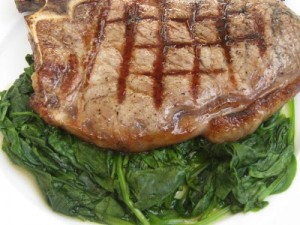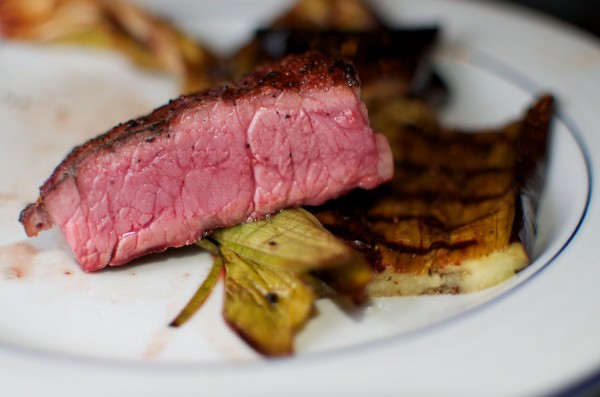Almost everyone sucks at making steak. Misinformation abounds. Fiascos are the norm. The worst thing is that most people are too polite/kind/naive to do anything but praise whatever horror show lands on their plate. The good news is that making great steak is only a little more difficult than making bad steak, and you won’t have to spend a cent more.
So. What makes a good steak?
- Good starting material. Good quality, good cut, well butchered (duh)
- A dark brown, flavorful, crust
- Pink (rare, or medium-rare are acceptable, no more!) from edge to edge, no ring of well-done yuck ringing the yummy pink center.
We will get into choosing a good piece of meat in a minute, but I want to illustrate how things go wrong. The most common is a failure to develop a good crust:

I DIDN'T ASK FOR BOILED STEAK
The second failure is to cook the center to the desired doneness, but also get a hideous ring of well done steak all around the edge:

GAH! I SEE RARE, MEDIUM AND WELL, ALL IN ONE STEAK
So. We need a good piece of meat, a good crust, and to be pink, from edge to edge. Let’s get started. Start with the meat. Any of the usuals will do, but some favorites of mine are ribeye, porterhouse, T-Bone, and NY Strip. No big surprises here. If you can afford it, buy something that doesn’t come from a hideous feed-lot, and has been dry-aged. Grass finished beef will cost you a pretty penny, and so will dry aged beef. Both grass finished and dry-aged costs a fortune. If you can afford it, good on you. If not, get the best quality you can afford, and dry age it at home.
Why do people get wan, gray, steaks that look like they have been boiled, with a hideous ring of well-done meat around the edges? Both are symptoms of the same problem. It is because people are inadvertently steaming their meat. Throw a steak onto a fire, (or a pan), and the surface moisture has to boil away before any crust starts to form. On top of that, the steam is 0ver-cooking the meat just below the surface. On top of that, the moisture cools the cooking grate or pan so that it isn’t hot enough to form a good crust. Even with a really hot fire/pan, by the time a crust forms, your steak is over-cooked.
The solution? Warm your steak gradually, and keep the surface as dry as possible! Then take a two temperature cooking approach, very-low, then super-hot.
Hey, what is this crust stuff anyway? Short answer: it is yum. Another short answer: The product of Maillard reactions and caramelization. Longer answer: sugars and amino acids react with each other at temperatures above 330º, and break down into many intermediate molecules. These intermediate molecules recombine in hundreds of different ways, creating hundreds of compounds with slightly different flavors. Many of these flavors are those we would describe as savory, meaty, chocolatey, fruity, buttery, nutty, etc. All those flavors together taste complex and deep, and…. yummy. So that brown crust is crucial to great flavor.
Not only does cooking it slow help your crust form, and keep the meat pink from edge to edge, but the slow cooking makes the meat more tender. The same enzymes (calpains and cathepsins) that are responsible for tenderizing meat during dry aging, become hyper active as you warm the steak above room temperature, making your steak even more tender. Those enzymes are rapidly killed if you use a high heat technique, so your steak won’t be as tender.
Really Good Steak On Coals
If you can’t get it together and find a way to cook over a live fire, go here for an indoor version of this recipe. Unless you are starting with dry aged, take it out of the package, pat it dry, and then let it sit uncovered on a rack in the fridge for hours, or even a day before cooking. If you are starting with dry-aged steak, the surface should be pretty dry already.
Take it out of the fridge a good hour before cooking, to let it warm a bit. Start your fire. Don’t use pressed “briquets”, whatever they are. They are almost always packed with fillers and release agents like clay and borax. Use a lump charcoal, or even dry wood cooked down to coals. You want a very low fire. If you have a grill thermometer, you want around 200-250 degrees. Very low. You are basically using your grill as an oven on “low” right now. Â Right before you are ready to cook it, pat it dry again, rub it with a very light coating of olive oil, then liberally sprinkle course ground sea salt and pepper over it. You probably want more than you think. Put the steak on the grill, away from direct heat, and close the lid. Depending on the thickness of the steak, heat of the fire, etc, cooking time could vary between 8-20 minutes (remember, the temperature is very low).
When the internal temperature of the steak reaches 90 degrees, take it off the grill, and tent it with foil. Now. Get your fire kicking ass. Open all the vents, and if available, throw on some wood chunks (applewood is nice). Get the fire going hot,  and wait until all the coals are  glowing red hot, and if you used some wood, wait until it is just collapsing to very hot coals. Give your coals a quick stir to knock the ash off. Don’t worry if this all takes a while, your steak resting under the foil is doing lots of good things. It is getting more tender (due to enzyme activity), and the temperature is evening throughout, helping us get the edge-to-edge pinkness that we want.  Now here is the exciting part. Pat your steaks dry one more time, then throw your steak directly on the hot coals! Yes, it seems like madness, but it works! Cook it for about 60-90 seconds (depending on how hot your coals are), flip it, cook for another 60-90 seconds, then take it off! You are looking for a nice dark brown crust. A few black spots are OK, but not too much. Don’t chicken out and take it out before the crust forms! If you are too chicken to put your lovely steaks directly on the coals (or you only have access to briquettes), you can take a more conventional approach; just get the coals really hot, put the grate very close to the coals (less than an inch), and cook them like that. The key is that the steak cooks very briefly at very high temperatures.
Take it off of the coals, and gently brush off any embers, and small bits of ash that have adhered to the steak. Don’t worry, the steak will be surprisingly clean, with only a little brushing. Now put it on a plate, tent it loosely with foil, and let it rest for at least 5 minutes, then serve!





8 Comments